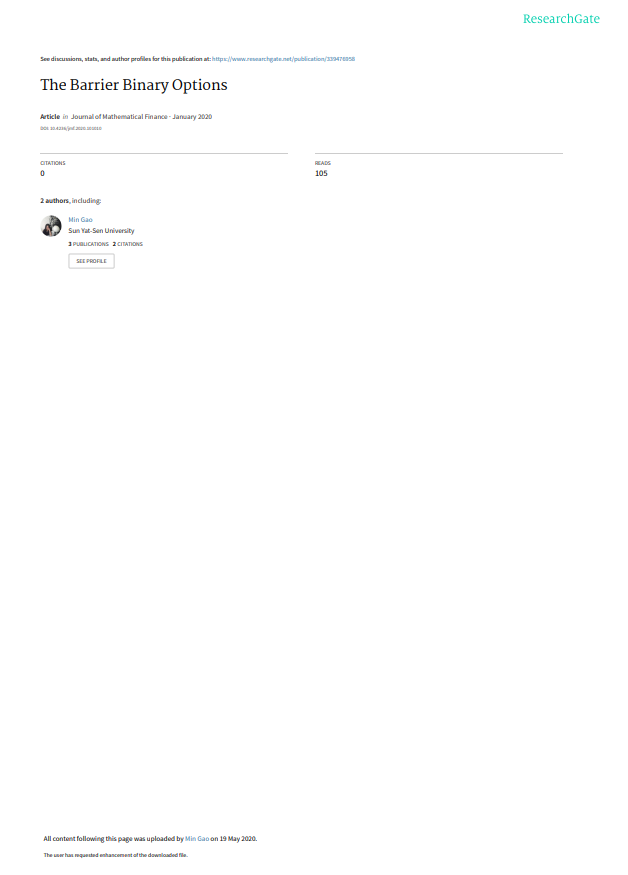The Barrier Binary Options by Min Gao, Zhenfeng Wei

Introduction
Barrier options on stocks have been traded in the OTC (Over-The-Counter)
market for more than four decades. The inexpensive price of barrier options
compared with other exotic options has contributed to their extensive use by in-
vestors in managing risks related to commodities, FX (Foreign Exchange) and
interest rate exposures.
Barrier options have the ordinary call or put pay-offs but the pay-offs are con-
tingent on a second event. Standard calls and puts have pay-offs that depend on
one market level: the strike price. Barrier options depend on two market levels:
the strike and the barrier. Barrier options come in two types: in options and out
options. An in option or knock-in option only pays off when the option is in the
money with the barrier crossed before the maturity. When the stock price
crosses the barrier, the barrier option knocks in and becomes a regular option. If
the stock price never passes the barrier, the option is worthless no matter it is in
the money or not. An out barrier option or knock-out option pays off only if the
option is in the money and the barrier is never being crossed in the time hori-
zon. As long as the barrier is not being reached, the option remains a vanilla ver-
sion. However, once the barrier is touched, the option becomes worthless imme-
diately. More details about the barrier options are introduced in and.
The use of barrier options, binary options, and other path-dependent options
has increased dramatically in recent years especially by large financial institu-
tions for the purpose of hedging, investment and risk management. The pricing
of European knock-in options in closed-form formulae has been addressed in a
range of literature (see and reference therein). There are two types of
the knock-in option: up-and-in and down-and-in. Any up-and-in call with strike
above the barrier is equal to a standard call option since all stock movements
leading to pay-offs are knock-in naturally. Similarly, any down-and-in put with
strike below the barrier is worth the same as a standard put option. An investor
would buy knock-in option if he believes the movements of the asset price are
rather volatile. Rubinstein and Reiner provided closed form formulas for a
wide variety of single barrier options. Kunitomo and Ikeda derived explicit
probability formula for European double barrier options with curved boundaries
as the sum of infinite series. Geman and Yor [8] applied a probabilistic approach
to derive the Laplace transform of the double barrier option price. Haug has
presented analytic valuation formulas for American up-and-input and down-and-in
call options in terms of standard American options. It was extended by Dai and
Kwok to more types of American knock-in options in terms of integral re-
presentations. Jun and Ku derived a closed-form valuation formula for a digit
barrier option with exponential random time and provided analytic valuation for-
mulas of American partial barrier options in. Hui used the Black-Scholes
environment and derived the analytical solution for knock-out binary option
values. Gao, Huang and Subrahmanyam proposed an early exercise premium
presentation for the American knock-out calls and puts in terms of the optimal
free boundary.
There are many different types of barrier binary options. It depends on: 1) in
or out; 2) up or down; 3) call or put; 4) cash-or-nothing or asset-or-nothing. The
European valuation was published by Rubinstein and Reiner. However, the
American version is not the combination of these options. This paper considers
a wide variety of American barrier binary options and is organised as follows. In
Section 2 we introduce and set the notation of the barrier binary problem. In
Section 3 we formulate the knock-in binary options and briefly review the exist-
ing work on knock-in options. In Section 4 we formulate the knock-out binary
option problem and give the value in the form of the early exercise premium re-
presentation with a local time term. We conduct a financial analysis in Section 5
and discuss the application of the barrier binary options in the current financial
market.




